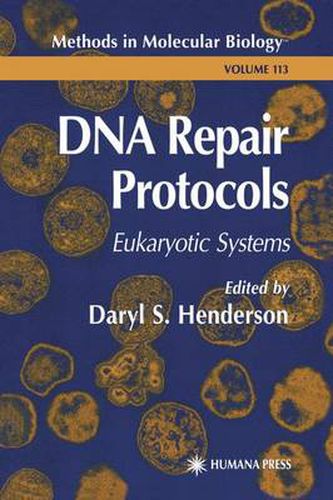Readings Newsletter
Become a Readings Member to make your shopping experience even easier.
Sign in or sign up for free!
You’re not far away from qualifying for FREE standard shipping within Australia
You’ve qualified for FREE standard shipping within Australia
The cart is loading…






This title is printed to order. This book may have been self-published. If so, we cannot guarantee the quality of the content. In the main most books will have gone through the editing process however some may not. We therefore suggest that you be aware of this before ordering this book. If in doubt check either the author or publisher’s details as we are unable to accept any returns unless they are faulty. Please contact us if you have any questions.
The field of eukaryotic DNA repair is enjoying a period of remarkable growth and discovery, fueled by technological advances in molecular biol- ogy, protein biochemistry, and genetics. Notahle achievements include the molecular cloning of multiple genes associated with classical human repair disorders, such as xeroderma pigmentosum, Cockayne syndrome, and ataxia telangiectasia; elucidation of the core reaction of nucleotide excision repair (NER); the discovery that certain NER proteins participate not only in repair, but also in transcription; recognition of the crucial role played by mismatch repair processes in maintenance of genome stability and avoidance of cancer; the findings that the tumor suppressor protein p53 is mutated in many types of cancer, and has a key role in directing potentially malignant, genotoxin-dam- aged cells towards an apoptotic fate; and the discovery and elaboration of DNA darnage (and replication) checkpoints, which placed repair phenomenol- ogy firmly within a cell-cycle context. Of course, much remains to be learned about DNA repair. Tothat end, DNA Repair Protocols: Eukaryotic Systems is about the tools and techniques that have helped propel the DNA repair field into the mainstream of biological research. DNA Repair Protoco/s: Eukaryotic Systems provides detailed, step-by- step instructions for studying manifold aspects of the eukaryotic response to genomic injury. The majority of chapters describe methods for analyzing DNA repair processes in mammalian cells. However, many ofthose techniques can be applied with only minor modification to other systems, and vice versa.
$9.00 standard shipping within Australia
FREE standard shipping within Australia for orders over $100.00
Express & International shipping calculated at checkout
This title is printed to order. This book may have been self-published. If so, we cannot guarantee the quality of the content. In the main most books will have gone through the editing process however some may not. We therefore suggest that you be aware of this before ordering this book. If in doubt check either the author or publisher’s details as we are unable to accept any returns unless they are faulty. Please contact us if you have any questions.
The field of eukaryotic DNA repair is enjoying a period of remarkable growth and discovery, fueled by technological advances in molecular biol- ogy, protein biochemistry, and genetics. Notahle achievements include the molecular cloning of multiple genes associated with classical human repair disorders, such as xeroderma pigmentosum, Cockayne syndrome, and ataxia telangiectasia; elucidation of the core reaction of nucleotide excision repair (NER); the discovery that certain NER proteins participate not only in repair, but also in transcription; recognition of the crucial role played by mismatch repair processes in maintenance of genome stability and avoidance of cancer; the findings that the tumor suppressor protein p53 is mutated in many types of cancer, and has a key role in directing potentially malignant, genotoxin-dam- aged cells towards an apoptotic fate; and the discovery and elaboration of DNA darnage (and replication) checkpoints, which placed repair phenomenol- ogy firmly within a cell-cycle context. Of course, much remains to be learned about DNA repair. Tothat end, DNA Repair Protocols: Eukaryotic Systems is about the tools and techniques that have helped propel the DNA repair field into the mainstream of biological research. DNA Repair Protoco/s: Eukaryotic Systems provides detailed, step-by- step instructions for studying manifold aspects of the eukaryotic response to genomic injury. The majority of chapters describe methods for analyzing DNA repair processes in mammalian cells. However, many ofthose techniques can be applied with only minor modification to other systems, and vice versa.